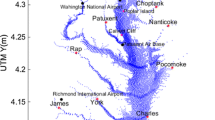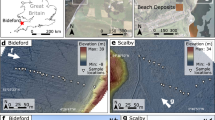Abstract
A mathematical model was used to predict the effect of climate change on soft and hard rock coasts in a 2 m tidal environment. Erosional equations represented the effect of wave impact and bottom generated shear stresses in the intertidal and subtidal zones. Model runs were made for: 2900 years with constant sea level; a further 100 years, representing the last century, with either constant or slow sea level rise (0.2 m per century); and another 100 years, representing the present century, with either slow or fast (1 m per century) sea level rise, and with either no change in storm frequency or with a 10% increase in the frequency of the highest waves. The results suggest that rising sea level will trigger faster rates of cliff recession, whereas increased storm wave frequency may have only a fairly minor effect on erosional efficacy. Model runs were used to derive a series of predictive equations relating cliff recession during the present and last centuries.
Similar content being viewed by others
References
Allan JC, Komar PD (2006) Climate controls on US west coast erosion processes. J Coast Res 22:511–529
Amos CL, Daborn GR, Christian HA, Atkinson A, Robertson A (1992) In situ erosion measurements on fine-grained sediments from the Bay of Fundy. Mar Geol 108:175–196
Balsillie JH, Tanner WF (2000) Red flags on the beach, part II. J Coast Res 16:iii–x
Bishop CT, Skafel MG, Nairn R (1992) Cohesive profile erosion by waves. In: Proc 23rd coast engnr conf, pp 2976–2989
Bray MJ, Hooke JM (1997) Prediction of soft-cliff retreat with accelerating sea-level rise. J Coast Res 13:453–467
Caires S, Swail VR, Wang XL (2006) Projection and analysis of extreme wave climate. J Clim 19:5581–5605
Carvalho F (2003) Elementos do clima de agitação marítima no Grupo Central dos Açores. Instituto de Meteorologia, Lisboa
CEM (2002) Coastal engineering manual. US Army Corps Engnrs, Washington. Engineer Manual 1110-2-1100 (6 volumes)
CERC (1977) Shore protection manual. Coast Engnr Res Center, U.S. Army Corps Engnrs, Washington
Coakley JP, Rukavina NA, Zeman AJ (1986) Wave-induced subaqueous erosion of cohesive tills: preliminary results. In: Skafel MG (ed) Proceedings of the symposium on cohesive shores. Nat Res Council Canada (ACROSES), Ottawa, pp 120–136
Davidson-Arnott RGD (1986) Rates of erosion of till in the nearshore zone. Earth Surf Proc Landf 11:53–58
Davidson-Arnott RGD, Ollerhead J (1995) Nearshore erosion on a cohesive shoreline. Mar Geol 122:349–365
Dickson ME, Walkden MJA, Hall JW (2007) Systemic impacts of climate change on an eroding coastal region over the twenty-first century. Clim Change 84:141–166
Dornbusch U, Robinson DA, Moses CM, Williams RBG (2008) Temporal and spatial variations of the chalk cliff retreat rate in East Sussex, 1873–2001. Mar Geol 249:271–282
Eurosion (2004) Living with coastal erosion in Europe: sediment and space for sustainability. Available via DIALOG. http://www.eurosion.org/reports-online/reports.html. Accessed 09 Sept 2010
Fisheries and Oceans Canada (2006) Canadian tide and current tables. Ottawa, Canada. Available via DIALOG. http://www.waterlevels.gc.ca/english/Canada.shtml. Accessed 09 Sept 2010
Griggs GB, Patsch KB (2004) California’s coastal cliffs and bluffs. In: Hampton MA, Griggs GB (eds) Formation, evolution and stability of coastal cliffs—status and trends. U.S. Geol Surv Prof Paper 39–50, pp 53–64
Hall AM, Hansom JD, Jarvis J (2008) Patterns and rates of erosion produced by high energy wave processes on hard rock headlands: the Grind of the Navir, Shetland, Scotland. Mar Geol 248:28–46
Hanna E, Huybrechts P, Steffen K, Cappelen J, Huff R, Shuman C, Irvine-Fynn T, Wise S, Griffiths M (2008) Increased runoff from melt from the Greenland Ice Sheet: a response to global warming. J Clim 21:331–341
IPCC (2007) Climate change 2007. The physical science basis. In: Solomon S, Qin D, Manning M (eds) Contribution of working group I to the fourth assessment report of the Intergovernmental Panel on Climate Change. Available via DIALOG. http://www.ipcc.ch/. Accessed 09 Sept 2010
Justensen P (1988) Turbulent wave boundary layers. Inst Hydrodyn Hydraul Engnr, Tech Univ Denmark, Lyngby, Denmark, series paper 43
Kamphuis JW (1990) Influence of sand or gravel on the erosion of cohesive sediment. J Hydraul Res 28:43–53
Kirk RM (1977) Rates and forms of erosion on the tidal platforms at Kaikoura Peninsula, South Island, New Zealand. New Zealand. J Geol Geophys 20:571–613
Komar PD, Allan JC (2008) Increasing hurricane-generated wave heights along the U.S. east coast and their climate controls. J Coast Res 24:479–488
Naylor LA, Stephenson WJ (2010) On the role of discontinuities in mediating shore platform erosion. Geomorphology 114:89–100
Naylor LA, Stephenson WJ, Trenhaile AS (2010) Rock coast geomorphology: recent advances and future research directions. Geomorphology 114:3–11
Nicholls RJ, Wong PP, Burkett VR, Codignotto JO, Hay JE, McLean RF, Ragoonaden S, Woodroffe CD (2007) Coastal systems and low-lying areas. In: Parry ML, Canziani OF, Palutikof JP, van der Linden PJ, Hanson CE (eds) Climate change 2007: impacts, adaptation and vulnerability. Contribution of working group II to the fourth assessment report of the Intergovernmental Panel on Climate Change. Cambridge University Press, Cambridge, pp 315–356
Philpott KL (1984) Comparison of cohesive coasts and beach coasts. In: Kamphuis JW (ed) Proceedings, coastal engineering in Canada. Queen’s University, Kingston, pp 227–244
Porter NJ, Trenhaile AS, Prestanski KJ, Kanyaya JI (2010) Patterns of surface downwearing on shore platforms in eastern Canada. Earth Surf Proc Landf 35:1793–1810
Pritchard HD, Vaughan DG (2007) Widespread acceleration of tidewater glaciers on the Antarctic Peninsula. J Geophys Res 112:F03S29
Smart CC, Hale PB (1987) Exposure and inundation statistics from published tide tables. Comput Geosci 13:357–368
Stephenson WJ, Kirk RM (1998) Rates and patterns of erosion on inter-tidal shore platforms, Kaikoura Peninsula, South Island, New Zealand. Earth Surf Proc Landf 23:1071–1085
Stephenson WJ, Kirk RM (2000) Development of shore platforms on Kaikoura Peninsula, South Island, New Zealand. Part one: the role of waves. Geomorphology 32:21–41
Storlazzi DD, Griggs GB (2000) Influence of El Niño-Southern Oscillation (ENSO) events on the evolution of central California’s shoreline. Geol Soc Am Bull 112:236–249
Sunamura T (1978) A model of the development of continental shelves having erosional origin. Geol Soc Am Bull 89:504–510
Sunamura T (1985) A simple relationship for predicting wave height in the surf zone with a uniformly sloping bottom. Trans Jpn Geomorph Union 6–4:361–364
Sunamura T (1992) The geomorphology of rocky coasts. Wiley, Chichester
Swantesson JOH, Gómez-Pujol L, Cruslock EM, Forns JJ, Balaguer P (2006) Processes and patterns of erosion and downwearing on micro-tidal rock coasts in Sweden and the western Mediterranean. In: Robinson DA, Lageat Y (eds) European shore platform dynamics. Z Geomorph Suppl. Band 144:137–160
Trenhaile AS (1987) The geomorphology of rock coasts. Oxford University Press, Oxford
Trenhaile AS (2000) Modeling the evolution of wave-cut shore platforms. Mar Geol 166:163–178
Trenhaile AS (2001) Modeling the Quaternary evolution of shore platforms and erosional continental shelves. Earth Surf Proc Landf 26:1103–1128
Trenhaile AS (2002) Modeling the development of sloping marine terraces on tectonically mobile rock coasts. Mar Geol 185:341–361
Trenhaile AS (2004) Modeling the accumulation and dynamics of beaches on shore platforms. Mar Geol 206:55–72
Trenhaile AS (2005) Modelling the effect of waves, weathering and beach development on shore platform development. Earth Surf Proc Landf 30:613–634
Trenhaile AS (2008) Modelling the role of weathering on shore platform development. Geomorphology 94:24–39
Trenhaile AS (2009) Modelling the erosion of cohesive clay coasts. Coast Eng 56:59–72
Trenhaile AS (2010) The effect of Holocene changes in relative sea level on the morphology of rocky coasts. Geomorphology 114:30–41
Trenhaile AS, Kanyaya JI (2007) The role of wave erosion on sloping and horizontal shore platforms in macro- and mesotidal environments. J Coast Res 23:298–309
Walkden M, Dickson M (2008) Equilibrium erosion of soft rock shores with a shallow or absent beach under increased sea level rise. Mar Geol 251:75–84
Wang XL, Zwiers F, Swail V (2004) North Atlantic ocean wave climate change scenarios for the twenty-first century. J Clim 17:2368–2383
Zeman AJ (1986) Erodibility of Lake Erie undisturbed tills. In: Skafel MG (ed) Proceedings of the symposium on cohesive shores. Nat Res Council Canada (ACROSES), Ottawa, pp 150–169
Zhang K, Douglas BC, Leatherman SP (2004) Global warming and coastal erosion. Clim Change 64:41–58
Author information
Authors and Affiliations
Corresponding author
Rights and permissions
About this article
Cite this article
Trenhaile, A.S. Predicting the response of hard and soft rock coasts to changes in sea level and wave height. Climatic Change 109, 599–615 (2011). https://doi.org/10.1007/s10584-011-0035-7
Received:
Accepted:
Published:
Issue Date:
DOI: https://doi.org/10.1007/s10584-011-0035-7




